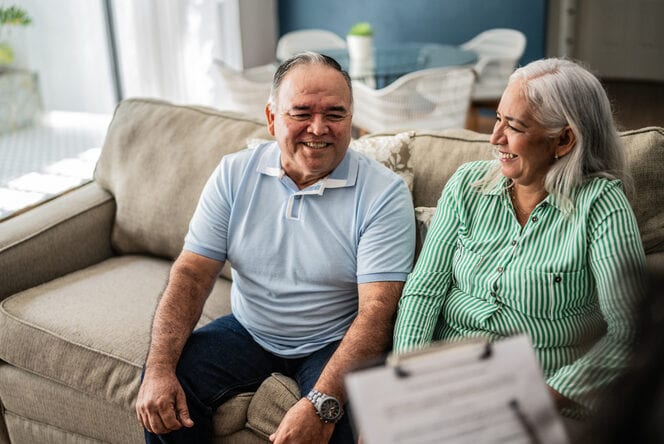In this article
From more free time for hobbies to less stamina for tackling yard work, life at home starts to look a bit different as adults near retirement age. This is why many choose to move into communities designed to meet their changing needs around the age of 55, a rising trend that’s being fueled by the growing population of retirees in the U.S.
“Demand for 55-and-over living is at an all-time high,” says Kris Maher, senior vice president of community development at Rancho Mission Viejo, a master-planned 55+ community in Orange County, California. “For many, the pressures of demanding careers are easing and busy years of raising a family are giving way to more personal freedom. It’s often a period when they can finally ask themselves, ‘What’s next for me?’”
But for older adults who are also considering what’s next for loved ones, many wonder if 55-and-over communities allow younger residents. Here, experts explain who can live in senior communities, plus answer common questions about age restrictions and requirements so families can better plan for the future.
Key takeaways
- A small percentage of residents under 55 can live in a senior community as long as 80% of homes within the building or neighborhood are occupied by an adult age 55 or older.
- Senior communities set their own rules for the number of residents under 55 who are permitted to live on the property, but typically spouses and adult children are allowed.
- Someone under age 55 can own a home in a 55-and-over community so long as its permanent residents comply with age and occupancy requirements at all times.
Who lives in 50-and-over communities?
Whether it’s an apartment building, neighborhood or active senior living community, every type of 55-and-over community features housing that is mostly occupied by adults who are age 55 or older. These homes are designed to meet the needs of aging adults by featuring accessible layouts and convenient on-site amenities like gyms to support an active lifestyle.
“For many of our 55+ homebuyers, it’s time to downsize into a home that feels more comfortable and manageable,” Maher says. “For others, it’s about living near neighbors who share a similar stage of life that offers access to wellness, activities, opportunities to explore new hobbies and a lifestyle that supports health and connection literally right out the backdoor.”
“The Housing for Older Persons Act (HOPA)… allows communities to legally restrict residency to adults 55 and older as long as at least 80% of occupied units have someone who is 55 or older.”
— Kris Maher, senior vice president of community development
Can someone under 55 live in a senior community?
The short answer is yes. Even if senior housing is marketed as a 55-and-over community, U.S. law only requires that the majority — not all — of the people living there be adults who are 55 years of age or older, according to experts.
“The Housing for Older Persons Act (HOPA) is the regulation that allows communities to legally restrict residency to adults 55 and older as long as at least 80% of occupied units have someone who is 55 or older,” Maher explains. “Therefore, a small percentage of residents under 55 can live in the community, depending on the specific rules of the community.”
This is why it’s common to find younger adults living with a senior family member in 55-and-over communities — most often spouses, adult children or caregivers. However, every community sets their own rules and restrictions for residents under 55.
Common rules for people under 55 in senior communities
Every 55-and-over community limits the overall number of adults who are not 55 in order to keep the community HOPA-compliant, explains Allison Jaffe, a licensed real estate broker and certified seniors real estate specialist (SRES®) based in New Rochelle, New York.
“There is not a deep list of requirements when it comes to what 55-and-over communities must adhere to by law,” Jaffe says. “But they must maintain the occupancy requirement of one member of the household being at least 55 in the majority of units or else the property will jeopardize their status to legally restrict the ages of residents.”
Additionally, in order to ensure a senior community delivers on the calm atmosphere and mature neighbors most residents are seeking, most 55-and-over communities will have specific criteria that younger residents must meet. For example, within Rancho Mission Viejo’s 55+ Gavilán Ridge neighborhoods, residents who are 55 years of age or older are referred to as a “qualifying” resident, Maher explains. A younger adult is allowed to live in a qualifying resident’s home as a “qualified permanent resident” but they have to meet at least one of the following criteria:
- Must be a spouse or domestic partner of the qualifying resident; or
- Must be 45 years of age or older; or
- Must provide primary physical or economic support to the qualifying resident; or
- Must provide live-in, long-term terminal or hospice care to the qualifying resident for compensation, or is a family member of the qualifying resident who provides that care.
“The age and occupancy restrictions only apply to those who intend to occupy the residence on a permanent basis.”
— Kris Maher
Frequently asked questions about being under 55 in a senior community
Since age criteria varies from community to community, it’s important to ask to review it before making a decision to move. Here, experts weigh in on a few more common questions that may pop up around restrictions for people under 55 who want to live in a senior community:
Can someone with a disability live in a senior community if they aren’t 55?
Yes, as long as a community can still ensure rules and restrictions for residents under 55 are met. For example, there are no restrictions to individuals with disabilities looking to live in Gavilán Ridge, Maher says, so long as the condition of the person with the disability who is under 55 years old lives with a qualifying resident. “Then, they may permanently reside as a qualified permanent resident in the home until the disabling condition ends,” Maher says.
Can you buy or rent a home in a senior community before you turn 55?
Rules vary by community, but there are typically no age restrictions on who can purchase a residence in a 55-and-over community. This often happens in the case of an adult child buying a home for parents, Maher notes. “The age and occupancy restrictions only apply to those who intend to occupy the residence on a permanent basis,” Maher says.
Can a person under 55 own or inherit a home in a senior community?
Yes, according to Maher. “However, nonresident owners are responsible for ensuring that all tenants and other residents of the property timely and fully comply with the age and occupancy requirements at all times,” she says.
Can kids and grandkids visit a 55-and-over community?
Absolutely. In fact, sometimes older adults choose to live in a resort-style active senior living community simply to have a cool place that kids and grandkids can’t wait to visit, Maher says. Rules about how long younger visitors can stay will vary by community and are typically provided upon moving in with other standards community policies, Jaffe notes.
Are there senior communities with no age restrictions?
For older adults simply looking to adopt a calmer, more convenient lifestyle as they age, 55+ senior housing isn’t the only option out there. In this case, Jaffe recommends considering shopping for a home in what’s called a naturally occurring retirement community (NORC), or a community that is not age-restricted yet still populated mostly by seniors.
“There is a generational life cycle to any community, whether it’s a subdivision of suburban houses or a rental building,” says Jaffe. “NORCs are communities where people moved in when they were middle age, but then they aged in place. Now you’ve got a community where there is a fairly mature population because a lot of these people have lived there a long time.”
NORCs can also be master-planned communities that attract seniors because they boast the same resort-style amenities of active senior living communities, including social groups, activities, tennis courts and pools, Jaffe explains. One example in her area of New York is Heritage Hills, a housing community located in northern Westchester.
“Heritage Hills is not in any way a purpose built 55+ community, but people tend to move there in their 60s and 70s from Westchester mainly because they don’t want to leave the area yet they don’t want the big house anymore,” Jaffe says. “In communities like these, the population is typically very much over the age of 55 but it’s not restricted.”





